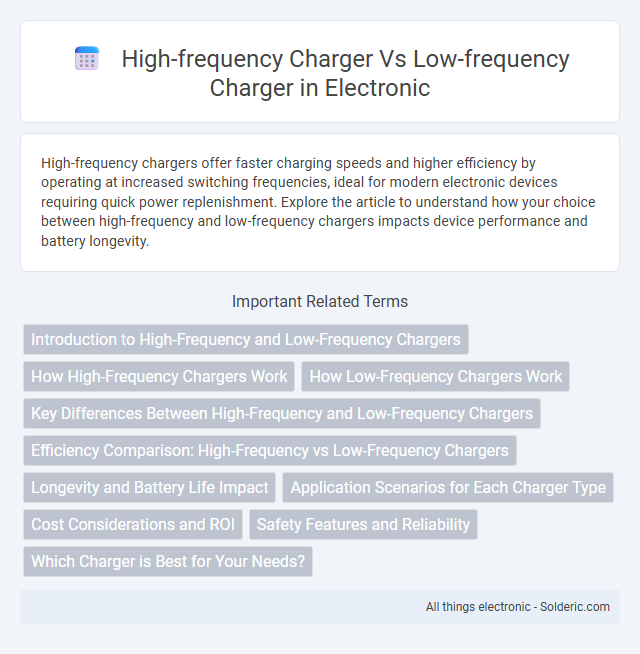High-frequency chargers offer faster charging speeds and higher efficiency by operating at increased switching frequencies, ideal for modern electronic devices requiring quick power replenishment. Explore the article to understand how your choice between high-frequency and low-frequency chargers impacts device performance and battery longevity.
Comparison Table
| Feature | High-frequency Charger | Low-frequency Charger |
|---|---|---|
| Operating Frequency | 20 kHz - 100 kHz | 50 Hz - 60 Hz |
| Size | Compact and lightweight | Bulky and heavy |
| Efficiency | High (85%-95%) | Moderate (70%-85%) |
| Heat Generation | Low heat output | High heat output |
| Cost | Higher initial cost | Lower initial cost |
| Application | Modern electric vehicles, portable electronics | Industrial batteries, older vehicle models |
| Reliability | Advanced control, sensitive to EMI | Robust and simple design |
| Power Density | High power density | Low power density |
Introduction to High-Frequency and Low-Frequency Chargers
High-frequency chargers use advanced electronic circuits operating at higher switching frequencies, resulting in smaller, lighter, and more efficient designs. Low-frequency chargers rely on traditional transformer technology with larger, heavier components and lower power conversion efficiency. Understanding these differences helps you choose the right charger based on performance, size, and energy consumption needs.
How High-Frequency Chargers Work
High-frequency chargers operate by converting AC power into high-frequency AC signals using electronic inverters, which significantly reduce the size and weight of the transformer and other components. These chargers provide faster charging speeds and higher efficiency compared to low-frequency chargers, as the high-frequency operation enhances power transfer and minimizes energy loss. Your device benefits from improved thermal management and compact design, making high-frequency chargers ideal for portable and quick-charging applications.
How Low-Frequency Chargers Work
Low-frequency chargers operate by converting AC power into a lower frequency signal, typically around 50-60 Hz, which then flows through a transformer to reduce voltage and provide a smooth DC output for battery charging. This design allows low-frequency chargers to handle higher power loads with robust, durable components, making them ideal for heavy-duty and industrial battery charging applications. Your choice of a low-frequency charger ensures reliable and efficient energy transfer, especially for deep-cycle batteries requiring stable charging conditions.
Key Differences Between High-Frequency and Low-Frequency Chargers
High-frequency chargers utilize higher switching frequencies, resulting in smaller, lighter, and more energy-efficient power supplies compared to low-frequency chargers that operate at lower frequencies and tend to be bulkier and less efficient. High-frequency chargers offer faster charging speeds and better power conversion, making them ideal for modern electronic devices requiring quick, reliable power. Your choice between the two depends on the need for portability, efficiency, and charging speed in your application.
Efficiency Comparison: High-Frequency vs Low-Frequency Chargers
High-frequency chargers typically achieve efficiency rates above 90% due to their compact design and faster switching speeds, reducing energy loss during the conversion process. Low-frequency chargers, operating at slower switching frequencies, generally exhibit lower efficiency ranging between 80% and 85%, leading to increased heat generation and energy waste. Advances in semiconductor technology continue to widen the efficiency gap, making high-frequency chargers preferable for applications demanding energy conservation and reduced operational costs.
Longevity and Battery Life Impact
High-frequency chargers typically generate less heat during the charging process, which helps preserve battery longevity and maintain optimal battery life over time compared to low-frequency chargers. Low-frequency chargers often cause increased thermal stress and wear on battery cells, potentially leading to faster capacity degradation. Choosing a high-frequency charger can significantly reduce the risk of premature battery aging, ensuring improved long-term performance and reliability.
Application Scenarios for Each Charger Type
High-frequency chargers are ideal for electric vehicles and portable electronics due to their compact size, rapid charging capabilities, and higher efficiency. Low-frequency chargers excel in heavy-duty industrial applications and large battery systems where robustness, lower initial cost, and simpler design are prioritized. Your choice depends on the specific power requirements, space constraints, and charging speed needed for the application.
Cost Considerations and ROI
High-frequency chargers typically have higher upfront costs due to advanced electronics but offer greater energy efficiency and faster charging times, leading to quicker ROI for your operations. Low-frequency chargers, while cheaper initially, often incur higher energy and maintenance expenses, extending the payback period. Evaluating your energy consumption patterns and operational demands helps determine which charger offers the best long-term cost-effectiveness.
Safety Features and Reliability
High-frequency chargers offer advanced safety features such as precise thermal management, overvoltage protection, and real-time monitoring, enhancing reliability during rapid charging cycles. Low-frequency chargers typically provide robust durability with fewer electronic components, reducing failure points but often lack sophisticated protection systems found in high-frequency models. The integration of semiconductor technology in high-frequency chargers ensures higher efficiency and consistent performance, making them preferable for applications requiring stringent safety and dependable operation.
Which Charger is Best for Your Needs?
High-frequency chargers provide faster charging times and improved energy efficiency, making them ideal for users requiring quick and frequent battery replenishment. Low-frequency chargers tend to be more affordable and suitable for applications with less frequent charging demands or larger, stationary batteries. Evaluating your specific power needs and budget will help you determine whether a high-frequency or low-frequency charger best supports your energy management goals.
High-frequency charger vs Low-frequency charger Infographic

 solderic.com
solderic.com